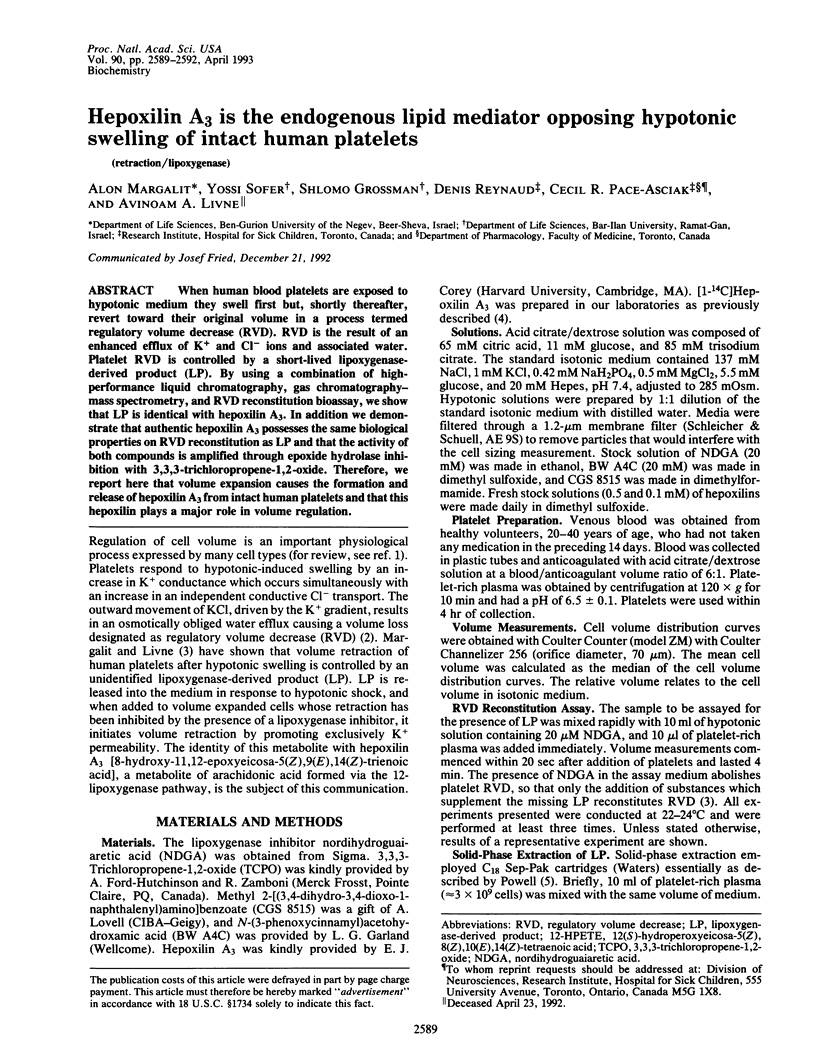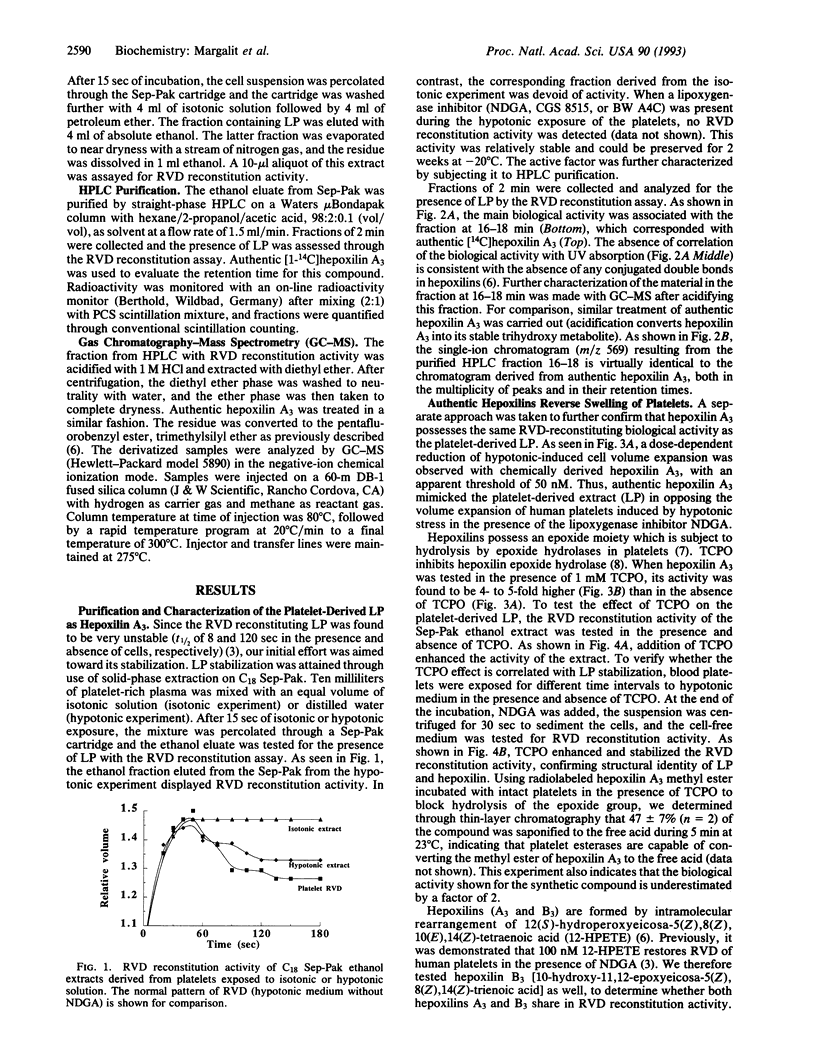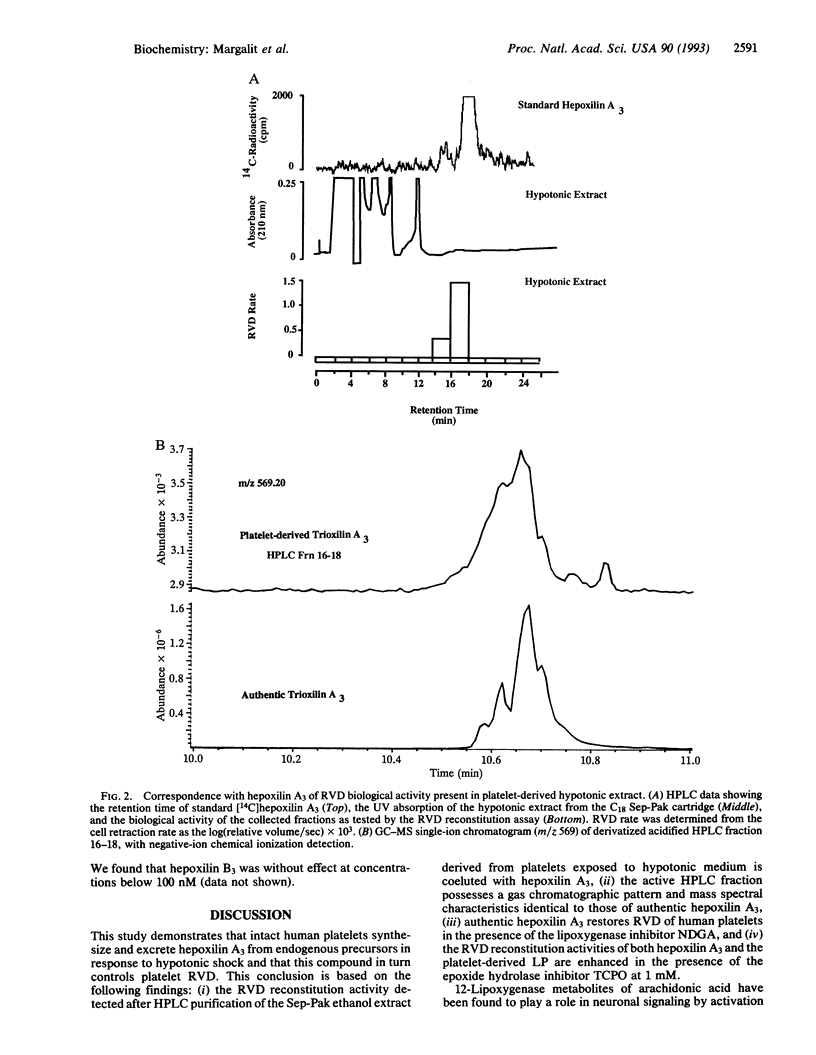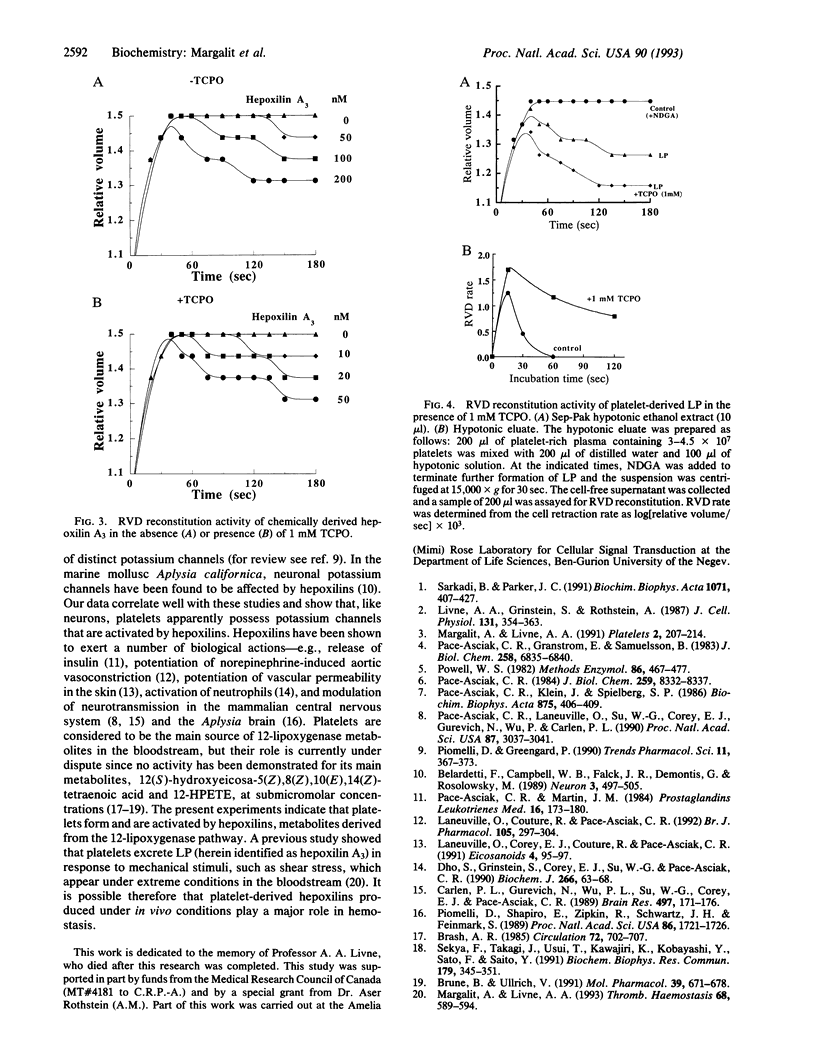Abstract
When human blood platelets are exposed to hypotonic medium they swell first but, shortly thereafter, revert toward their original volume in a process termed regulatory volume decrease (RVD). RVD is the result of an enhanced efflux of K+ and Cl- ions and associated water. Platelet RVD is controlled by a short-lived lipoxygenase-derived product (LP). By using a combination of high-performance liquid chromatography, gas chromatography-mass spectrometry, and RVD reconstitution bioassay, we show that LP is identical with hepoxilin A3. In addition we demonstrate that authentic hepoxilin A3 possesses the same biological properties on RVD reconstitution as LP and that the activity of both compounds is amplified through epoxide hydrolase inhibition with 3,3,3-trichloropropene-1,2-oxide. Therefore, we report here that volume expansion causes the formation and release of hepoxilin A3 from intact human platelets and that this hepoxilin plays a major role in volume regulation.
Full text
PDF



Selected References
These references are in PubMed. This may not be the complete list of references from this article.
- Belardetti F., Campbell W. B., Falck J. R., Demontis G., Rosolowsky M. Products of heme-catalyzed transformation of the arachidonate derivative 12-HPETE open S-type K+ channels in Aplysia. Neuron. 1989 Oct;3(4):497–505. doi: 10.1016/0896-6273(89)90208-0. [DOI] [PubMed] [Google Scholar]
- Brash A. R. A review of possible roles of the platelet 12-lipoxygenase. Circulation. 1985 Oct;72(4):702–707. doi: 10.1161/01.cir.72.4.702. [DOI] [PubMed] [Google Scholar]
- Brüne B., Ullrich V. 12-hydroperoxyeicosatetraenoic acid inhibits main platelet functions by activation of soluble guanylate cyclase. Mol Pharmacol. 1991 May;39(5):671–678. [PubMed] [Google Scholar]
- Carlen P. L., Gurevich N., Wu P. H., Su W. G., Corey E. J., Pace-Asciak C. R. Actions of arachidonic acid and hepoxilin A3 on mammalian hippocampal CA1 neurons. Brain Res. 1989 Sep 11;497(1):171–176. doi: 10.1016/0006-8993(89)90984-0. [DOI] [PubMed] [Google Scholar]
- Dho S., Grinstein S., Corey E. J., Su W. G., Pace-Asciak C. R. Hepoxilin A3 induces changes in cytosolic calcium, intracellular pH and membrane potential in human neutrophils. Biochem J. 1990 Feb 15;266(1):63–68. doi: 10.1042/bj2660063. [DOI] [PMC free article] [PubMed] [Google Scholar]
- Laneuville O., Corey E. J., Couture R., Pace-Asciak C. R. Hepoxilin A3 increases vascular permeability in the rat skin. Eicosanoids. 1991;4(2):95–97. [PubMed] [Google Scholar]
- Laneuville O., Couture R., Pace-Asciak C. R. Hepoxilins sensitize blood vessels to noradrenaline--stereospecificity of action. Br J Pharmacol. 1992 Feb;105(2):297–304. doi: 10.1111/j.1476-5381.1992.tb14249.x. [DOI] [PMC free article] [PubMed] [Google Scholar]
- Livne A., Grinstein S., Rothstein A. Volume-regulating behavior of human platelets. J Cell Physiol. 1987 Jun;131(3):354–363. doi: 10.1002/jcp.1041310307. [DOI] [PubMed] [Google Scholar]
- Margalit A., Livne A. A. Human platelets exposed to mechanical stresses express a potent lipoxygenase product. Thromb Haemost. 1992 Nov 10;68(5):589–594. [PubMed] [Google Scholar]
- Pace-Asciak C. R. Arachidonic acid epoxides. Demonstration through [18O]oxygen studies of an intramolecular transfer of the terminal hydroxyl group of (12S)-hydroperoxyeicosa-5,8,10,14-tetraenoic acid to form hydroxyepoxides. J Biol Chem. 1984 Jul 10;259(13):8332–8337. [PubMed] [Google Scholar]
- Pace-Asciak C. R., Granström E., Samuelsson B. Arachidonic acid epoxides. Isolation and structure of two hydroxy epoxide intermediates in the formation of 8,11,12- and 10,11,12-trihydroxyeicosatrienoic acids. J Biol Chem. 1983 Jun 10;258(11):6835–6840. [PubMed] [Google Scholar]
- Pace-Asciak C. R., Klein J., Speilberg S. P. Epoxide hydratase assay in human platelets using hepoxilin A3 as a lipid substrate. Biochim Biophys Acta. 1986 Feb 12;875(2):406–409. doi: 10.1016/0005-2760(86)90193-1. [DOI] [PubMed] [Google Scholar]
- Pace-Asciak C. R., Laneuville O., Su W. G., Corey E. J., Gurevich N., Wu P., Carlen P. L. A glutathione conjugate of hepoxilin A3: formation and action in the rat central nervous system. Proc Natl Acad Sci U S A. 1990 Apr;87(8):3037–3041. doi: 10.1073/pnas.87.8.3037. [DOI] [PMC free article] [PubMed] [Google Scholar]
- Pace-Asciak C. R., Martin J. M. Hepoxilin, a new family of insulin secretagogues formed by intact rat pancreatic islets. Prostaglandins Leukot Med. 1984 Nov;16(2):173–180. doi: 10.1016/0262-1746(84)90069-6. [DOI] [PubMed] [Google Scholar]
- Piomelli D., Greengard P. Lipoxygenase metabolites of arachidonic acid in neuronal transmembrane signalling. Trends Pharmacol Sci. 1990 Sep;11(9):367–373. doi: 10.1016/0165-6147(90)90182-8. [DOI] [PubMed] [Google Scholar]
- Piomelli D., Shapiro E., Zipkin R., Schwartz J. H., Feinmark S. J. Formation and action of 8-hydroxy-11,12-epoxy-5,9,14-icosatrienoic acid in Aplysia: a possible second messenger in neurons. Proc Natl Acad Sci U S A. 1989 Mar;86(5):1721–1725. doi: 10.1073/pnas.86.5.1721. [DOI] [PMC free article] [PubMed] [Google Scholar]
- Powell W. S. Rapid extraction of arachidonic acid metabolites from biological samples using octadecylsilyl silica. Methods Enzymol. 1982;86:467–477. doi: 10.1016/0076-6879(82)86218-6. [DOI] [PubMed] [Google Scholar]
- Sarkadi B., Parker J. C. Activation of ion transport pathways by changes in cell volume. Biochim Biophys Acta. 1991 Dec 12;1071(4):407–427. doi: 10.1016/0304-4157(91)90005-h. [DOI] [PubMed] [Google Scholar]
- Sekiya F., Takagi J., Usui T., Kawajiri K., Kobayashi Y., Sato F., Saito Y. 12S-hydroxyeicosatetraenoic acid plays a central role in the regulation of platelet activation. Biochem Biophys Res Commun. 1991 Aug 30;179(1):345–351. doi: 10.1016/0006-291x(91)91376-n. [DOI] [PubMed] [Google Scholar]


